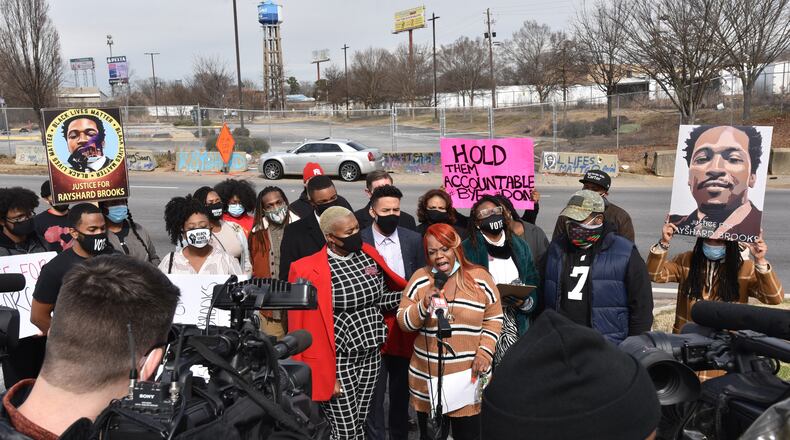A 1980s case of a man desperately seeking orange juice to stave off a diabetic coma saved Atlanta police Officer Garrett Rolfe from murder charges.
On Tuesday, Rolfe and fellow Officer Devin Brosnan were cleared of criminal charges in the June 12, 2020, shooting death of Rayshard Brooks in a Wendy’s parking lot.
During a news conference, special prosecutors Pete Skandalakis and Danny Porter often used the word “reasonable” to explain how Brooks’ death was a legal killing. The shooting came after an abrupt and brutal fight in which Brosnan got a concussion and was Tased by his own weapon, while Rolfe was thrown to the ground, punched and then ended up shooting Brooks twice after the fleeing man tried to Tase him.
The prosecutors offered up a milli-second by milli-second stop-frame analysis of the frenetic nighttime occurrence captured on several videos.
Skandalakis called the situation “rapidly evolving,” adding, “We did not look at this with 20/20 hindsight. Given the quickly changing circumstances, was it objectively reasonable that he used deadly force? We conclude it was.”
The language was taken almost verbatim from Graham v. Connor, a 1989 U.S. Supreme Court case that is the foundation of determining if a cop used excessive force.
This is where the orange juice comes in.
Credit: Natrice Miller / Natrice.Miller@ajc.com
Credit: Natrice Miller / Natrice.Miller@ajc.com
In 1984, Dethorne Graham felt his blood sugar crashing and urged a friend to drive him to a convenience store. There was a line inside, so Graham quickly left, drawing the suspicion of Charlotte, North Carolina, cop M.S. Connor, who stopped the car.
As the officer tried to figure out what was up, Graham grew frantic and was handcuffed. Connor and his colleagues then acted like jerks, according to the 1989 opinion written by Chief Justice William Rehnquist, the patron saint of conservative jurisprudence.
The cops ignored pleas from Graham and his friend. They mocked him, cursed him and roughed him up. He suffered a broken foot, cuts on his wrists, a bruised forehead, an injured shoulder and a ringing in his ear.
And then he lost the case.
“Use of force must be judged from the perspective of a reasonable officer on the scene, rather than with the 20/20 vision of hindsight,” Rehnquist wrote. “The calculus of reasonableness must embody allowance for the fact that police officers are often forced to make split-second judgments — in circumstances that are tense, uncertain and rapidly evolving — about the amount of force that is necessary in a particular situation.”
Even Thurgood Marshall, the famed civil rights lawyer and first Black justice, agreed with most of the unanimous ruling that set up the concept of the “objective reasonableness standard.”
It is hard to imagine that officers mistreating a man sinking into a diabetic coma were “objectively reasonable.” But that was the precedent set in stone.
For 33 years that standard has been employed in almost every such case, although the “objectiveness” of that hypothetical reasonable officer can be subjective.
What were the perceptions going through the cops’ minds when they pulled the trigger? Was there an imminent threat? What was the training? How fast did it occur? What was the person’s mental state? Was there a size differential? Did the officer use an escalation of force? (That is, using words first, then their hands, then a billy club or Taser and, finally, a gun.)
Graham v. Connor was employed in the case of Michael Brown, who was killed in Ferguson, Missouri. The prosecutor chose not to indict that officer. Lawyers for the cop who killed George Floyd argued the Graham case in court but lost because jurors didn’t see the reasonableness in slowly smothering a handcuffed man for 9-plus minutes.
The prosecutors this week said Rolfe pulled the trigger 1.1 seconds after Brooks fired a Taser over his shoulder while fleeing. That was moments after, as Porter said, Brooks “beat the crap out of the two officers” and while Rolfe was in hot pursuit.
As he started the news conference, Skandalakis spoke of the tense racial atmosphere of June 2020 when Brooks was killed.
“This is not like the George Floyd case,” he said. “This is not like the Ahmaud Arbery case,” referring to a Black man killed in early 2020 by three white civilians in Brunswick. The killers in both cases were convicted. (Also, in 2020, Porter, as Gwinnett County’s district attorney, prosecuted two white cops for beating a black motorist.)
Lance LoRusso, a former cop who is Rolfe’s civil attorney, once wrote an article, saying, “The solid bedrock of Graham v. Connor provides a strong foundation for (law enforcement officers) doing the work few in society are willing to do.”
However, plaintiff’s lawyers Chris Stewart and Justin Miller, who represent Brooks’ estate, think that “bedrock” is more like a quicksand that gives officers too much leeway. They say Brooks was fleeing and no longer a threat. They wanted the case to go to a jury, believing regular citizens may have a different sense of “reasonable” than two longtime prosecutors.
LoRusso and Brooks’ attorneys may end up in court one day — civil court, that is. Let’s see who wins that debate.
About the Author
Keep Reading
The Latest
Featured



